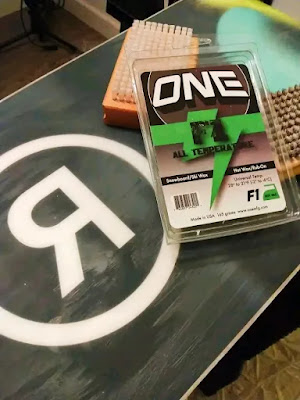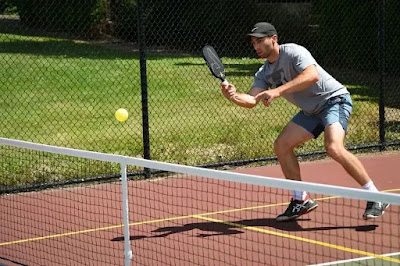Can You Just Rub Wax On A Snowboard?
Can You Rub Wax On A Snowboard?
Wax is essential to any snowboard because it adds gloss, hydrates the board, and improves performance. If you're new to waxing snowboards, it's easy to confuse "rub-on wax" with "rubbing-on wax," but they're not the same. Neither is a viable alternative.
Waxing a snowboard keeps it from drying out, but applying rub-on wax is not the best approach. Rub-on wax is a quick wax that lasts two or three usages before needing to be reapplied. Instead, choose an all-season, cold-weather, or warm-weather wax.
This article will address your burning beginner's concerns regarding waxing a snowboard, such as why you should wax, how long wax lasts, and whether or not your new snowboard needs waxing. Let's start with a closer look at rubbing wax on a snowboard.
 |
| Can You Just Rub Wax On A Snowboard? |
Can You Rub Wax On A Snowboard?
When you mention rubbing wax on a snowboard, we'll assume you're talking about rub-on wax, which has a thicker consistency than hot wax.
Rub-on wax is ideal for beginners because it only takes five minutes to apply. Its use is also relatively straightforward. So, what is the disadvantage?
On the other hand, rub-on wax only lasts for a short time on your snowboard. It's only intended to coat the board momentarily, so after two or three uses, it will be dry and need rewaxing.
Consider a couple more possibilities while buying snowboard wax.
All-Temperature Wax
All-season wax is intended to endure a wide range of snowboarding situations. However, the term "all-season" might be deceptive because it is supposed to operate well in a wide range of temperatures rather than all weather situations.
Nonetheless, all-season wax is helpful for every snowboarder since it allows you to retain speed and control in various circumstances.
All-season wax will keep you focused on the task, whether blazing down the slopes on a bright day or carving through fresh snow.
Although we wouldn't go so far as to state that any snowboard wax is entirely universal, all-temperature wax is as near as you can go.
Cold-Rated Wax
If you intend to snowboard in temperatures below 25 degrees Fahrenheit, you will need a particular type of wax on your board to avoid problems. That's where cold-rated wax comes in; it's made to endure extremely cold temperatures while providing a smooth ride.
Whether hitting the slopes or just spending time in the snow, cold-rated wax can help you relax and enjoy the experience.
Warm-Rated Wax
The temperature is crucial if you couldn't tell from the cold-rated wax. If the weather is warm, you should use a warm-rated wax. This wax is intended for use in temperatures over 25 degrees.
It is constructed of a blend of synthetic, microcrystalline, and paraffin waxes, giving it resilience and suppleness.
The microcrystalline gives durability, while the paraffin imparts softness to the wax.
 |
| rub on wax |
What Happens If You Don't Wax A Snowboard?
If you don't wax your snowboard, you'll notice a decrease in general performance, specifically agility, speed, and a shorter lifetime. Like your skin, your snowboard can dry up and break if it goes too long without moisture.
The board is more vulnerable to sun, wind, and moisture damage without wax.
In its basic form, wax protects the board from the weather and keeps it from drying out.
Let's examine how not waxing your snowboard affects agility, slows you down, and shortens its life.
Reduced Agility
Waxing your snowboard makes it more nimble. Waxes make the board feel alive, sensitive to turns, and useful for learning new tricks. However, the most significant benefit is simply receiving comments from your board relevant to your movement.
Waxing your snowboard will improve your performance while also making you more nimble. Long durations without wax can diminish a board's agility and responsiveness.
Sure, that's crucial for contests or tricks, but any kind of delay in reaction, or a board that doesn't move the way you want it to, may also be harmful.
Slower Speeds
Waxing the bottom of the board provides a slippery surface that allows the board to travel effortlessly through the snow. Without wax, the board tends to adhere to the snow, slowing you down and making turning and navigating more difficult.
Furthermore, a dry board is more prone to collect moisture from the snow, which might lead it to freeze, exacerbating the problem.
For these reasons, waxing your snowboard regularly is essential for maintaining top performance.
Consider why people used to use Crisco shortening on sled blades. Although it is now considered an extremely unsafe technique, the idea was that the oiled edges would go quicker on the snow.
When properly waxed, a snowboard goes faster, like a sled down a slope.
Less Longevity
While speed and agility are emphasized when it comes to waxing a snowboard, a coating of wax helps protect the snowboard from scratches and abrasions, keeping it looking new and lasting longer.
If you don't wax it, minor scratches on your snowboard will soon become severe gouges.
This will not only make your board appear ugly, but it will also shorten its longevity. And, with the cost of lift tickets rising, the last thing you need is the added expense of a new board.
Do You Need To Wax A New Snowboard?
The board will come with factory wax when you buy a new snowboard from a store (or online). Factory wax is both a blessing and a burden.
On the one hand, it's fantastic to go from the store to the slopes with your new board. On the other side, the wax doesn't last very long, so you'll have to reapply it frequently.
However, if you intend to use your new board immediately, waxing it again is unnecessary; the factory wax will be enough. If you plan on hitting the slopes later, giving your board a fresh coat of wax can be worth your time.
How Long Does Factory Snowboard Wax Last?
Most factory waxes for snowboards will survive multiple rides with careful care, but they have a relatively short lifespan. The lifespan of a factory wax is determined by several factors, including the wax's brand, the wax's type, how it was applied, and how frequently the board is used.
However, if you live in a humid environment or often ride damp, you may need to reapply your wax more frequently.
Furthermore, if you ride hard and subject your board to too much punishment, the factory wax will wear off faster.
Factory wax is often simply spray-on or rub-on wax - and based on what you just read about it, you already know it has a relatively short lifespan. It is then your job to apply another coat of wax to avoid the abovementioned situations.
Avoid rub-on wax, as it will take far too many reapplications to provide the necessary layer to maintain your board in excellent form. Use heated wax instead of rub-on waxes.
To retain top performance, reapply wax every few rides if you snowboard frequently.
However, if you only ride a few times a season, you can get away with simply waxing your board once or twice.
Waxing A Snowboard
Waxing a snowboard is vital to maintaining and keeping your board in good shape. As you know, a well-waxed board will ride faster and last longer than one that has yet to be waxed.
On the other hand, taking your board someplace to be waxed can be cumbersome, and you may want to avoid paying to have it done.
Can I Wax A Snowboard Myself?
 |
| Can I Wax A Snowboard Myself? |
Waxing a snowboard is easy; anyone can handle it at home in simple steps. Clean your board, melt your wax, iron wax to the board, let it cool and dry, then scrape off excess wax.
What Supplies And Tools Do You Need To Wax A Snowboard?
If you're thinking of waxing your snowboard, you'll need a few materials first, including:
- A base cleaner
- Material for packing (newspapers or rags)
- An iron - You can use your laundry room iron, but it cannot be used for garments afterward.
- A scraper for vinyl
- An excellent quality wax - all-weather is an intelligent choice if you need to know what conditions you'll be snowboarding in.
How To Wax A Snowboard In 5 Steps
- Clean your board using a base cleaner to remove any dirt, oil, or grime on its surface.
- Pack the space surrounding your desk with packing material to prevent wax from getting everywhere.
- Warm your iron to medium-high heat before pressing the wax against it. Allowing the drops of melted wax to fall onto the board, working from the edges first, then the center.
- Working from the tip to the tail, iron the wax into the board in a circular motion (Karate Kid "Wax on, wax off" method). You want the resin to be dispersed as evenly as possible.
- Allow the wax to cool and cure for a half-hour before scraping off any excess with your vinyl scraper, making sure to double-check the edges of the board.
- You're ready to hit the slopes after the wax has cooled and solidified!
Waxing Your Snowboard Matters
Any seasoned snowboarder will tell you that waxing your board is vital for keeping it in top shape.
Wax not only extends the life of your board, but it also improves your speed and performance on the slopes.
While new snowboards come with a coating of factory wax, it only stays for a short time. You may ride it right immediately, but you'll want to apply a better wax soon after.
Continuing to apply rub-on wax is neither cost-effective nor an efficient use of your time.
Warm-weather, cold-weather, and all-temperature waxes are the best types of wax for a snowboard. You can do it in five simple steps with simple tools and resources.
Sometimes, no amount of wax will suffice, and your only alternative is to get a new snowboard.
Other indicators that it's time to replace your board include the board's pop, camber, and rocker and its usage. So, beyond merely waxing, learn to know the condition of your board.
Waxing your snowboard is crucial to keeping it in good condition and will allow you to enjoy many seasons of fantastic snowboarding!





